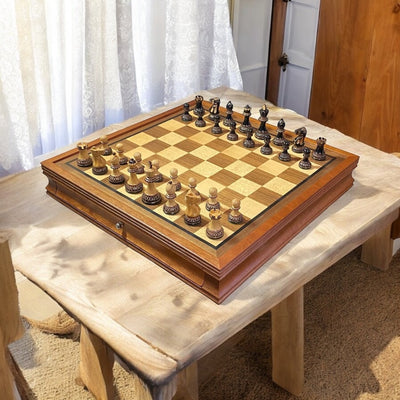Chess Sets, Strategy, and Planning: Expert Insights for Enthusiasts
Building a winning chess strategy is like planning a successful journey. You start by figuring out what you want to achieve on the chessboard. Then, you consider the pieces you have and how they fit into your plan. Some pieces are more important for certain strategies, depending on what you're trying to do.
Think of your strategy as a roadmap for the game. It guides you from your very first moves and helps you adapt to what your opponent is doing. While you can't predict every move your opponent will make, a good strategy gives you a strong foundation to make smart decisions during the game.
To get started, make sure you have a practical-sized chess set with the standard Staunton chess pieces. These pieces are easy to use and often come weighted for stability, so they won't tip over easily during the game.

Now, let's talk about the beginning of the game, called the opening. It's like the first steps of your journey. The opening involves a series of moves that have names like "openings," and you can find lots of information about them.
When you're deciding which moves to make in the opening, consider these four things:
- Develop Your Pieces: Think about where you want to place your pieces on the board. Their positions can affect the game for a long time.
- Protect Your King: Make sure your king is safe. You can do this by castling at the right time, which is like giving your king a fortress.
- Pawn Structure: Arrange your pawns strategically to avoid creating weak spots on the board. They're like the foundation of your plan.
Imagine playing chess as if you're strategizing a game of Capture the flag. Your ultimate goal is to protect your flag (represented by your king) while trying to capture your opponent's flag (their king). To achieve this, you need a well-thought-out plan.
1. Know Your Goals: Just like in any game, you need to know what you're aiming for. In chess, your goals might include controlling the center of the board, protecting your king, and attacking your opponent. Each piece has a role in helping you achieve these goals.
2. Understand Your Resources: In chess, your resources are your pieces – the pawns, knights, bishops, rooks, queens, and kings. Each piece has its unique abilities and limitations. Think of them as your team members, each with a specific job on the chessboard.
3. Planning Your Moves: The game of chess is divided into three parts: the opening, the middle game, and the endgame. The opening is like the first part of your strategy, where you get your team in position. In the middle game, you carry out your strategy, making moves to control the board and attack your opponent. Finally, the endgame is when there are fewer pieces on the board, and you focus on reaching your main goal – capturing the opponent's flag (king).
4. Know Your Openings: Think of chess openings as the different ways you can start your game. These openings have names like "Sicilian Defense" or "Queen's Gambit." They're like different game plans to get your pieces where you want them to be. Learning some basic openings can give you a strong start.
5. Protect Your King: Your king is like the VIP in the game. If the opponent captures your king, it's game over. So, just as you'd protect your flag at all costs in capturing the flag, in chess, you'll want to ensure your king's safety. This often involves a move called "castling," which is like putting your king in a well-guarded bunker.
6. Pawn Strategy: Your pawns are like your front line of defense. They move slowly but can control key areas of the board. Think of them as your soldiers advancing on the battlefield. How you move your pawns can greatly affect your overall strategy.






